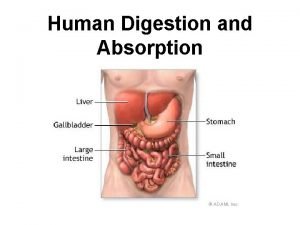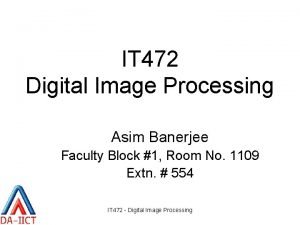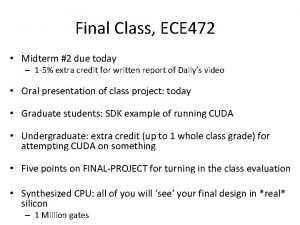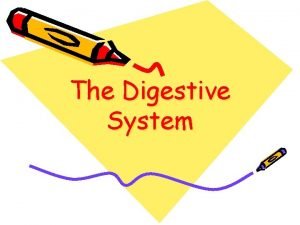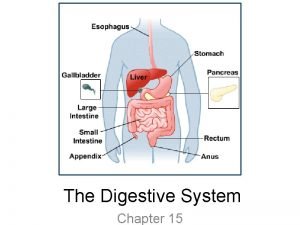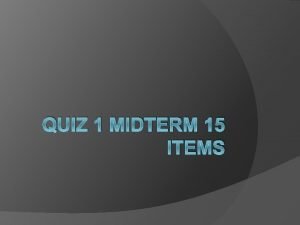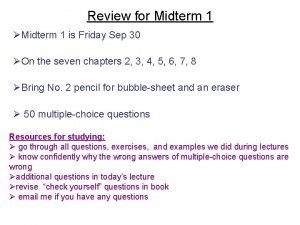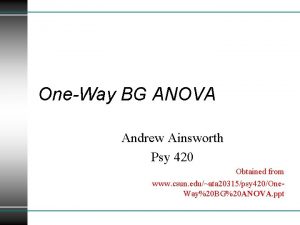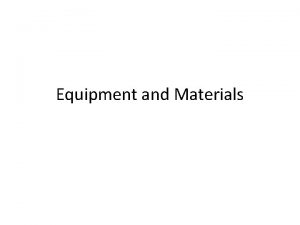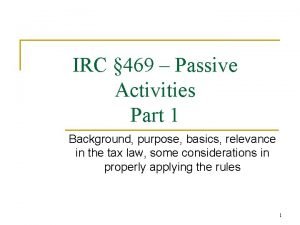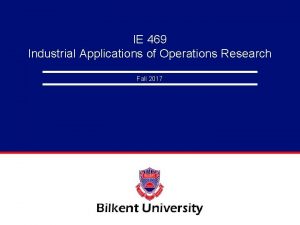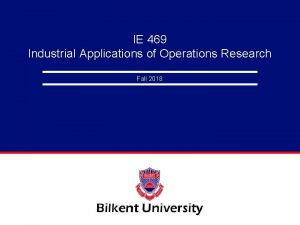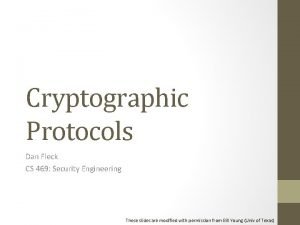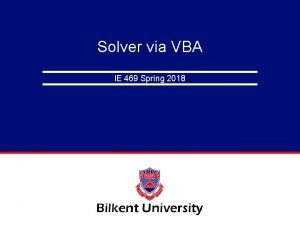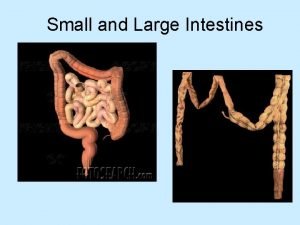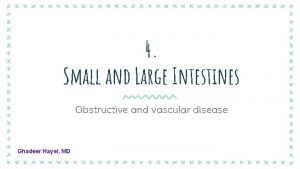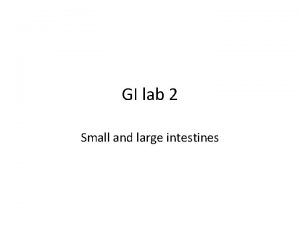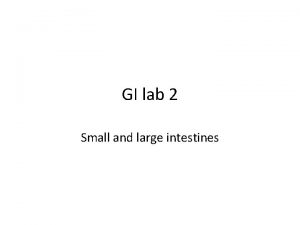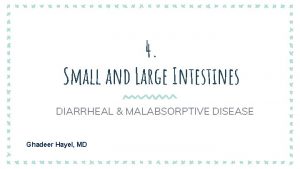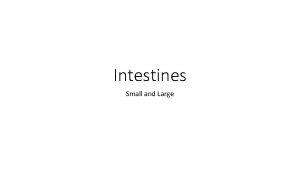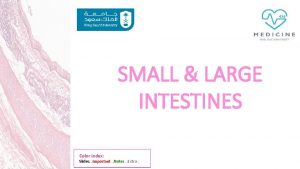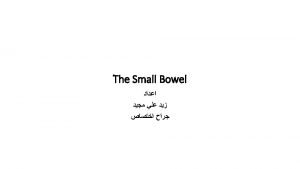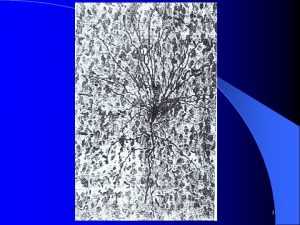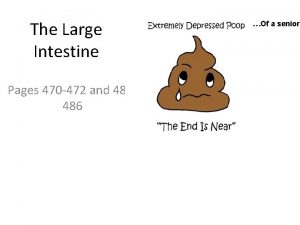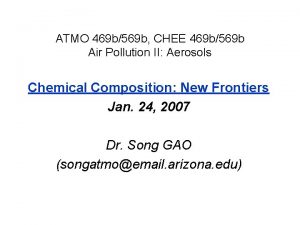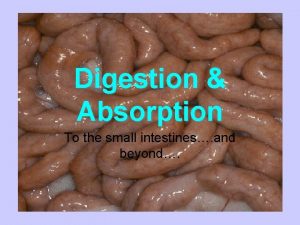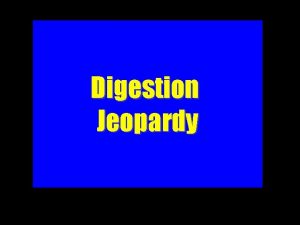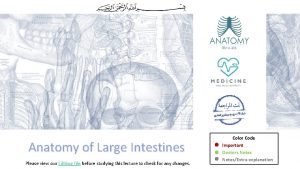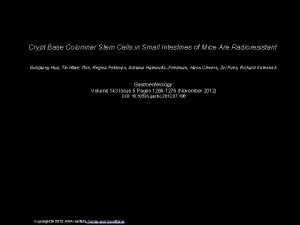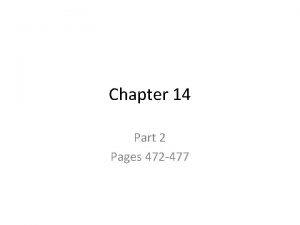The Small and Large Intestines Pages 469 472






















- Slides: 22

The Small and Large Intestines Pages 469 -472 and 483 -487

Small Intestine: Subdivisions From the stomach to the large intestine: Duodenum ◦ Attached to the stomach via the pyloric sphincter Jejunum Ileum ◦ Meets the large intestine at the ileocecal valve © 2015 Pearson Education, Inc.

Chemical Digestion of nutrients into the blood Begins in the small intestine via enzymes from: ◦ Intestinal cells ◦ Pancreas Pancreatic ducts carry enzymes to the duodenum ◦ Bile, formed by the liver, enters the duodenum via the bile duct The pancreatic and bile ducts come together to form a joint duct that releases into the duodenum – the hepatopancreatic ampulla © 2015 Pearson Education, Inc.

Figure 14. 6 The duodenum of the small intestine and related organs. Bile duct and sphincter Accessory pancreatic duct Pancreas Gallbladder Jejunum Duodenal papilla Hepatopancreatic ampulla and sphincter Main pancreatic duct and sphincter Duodenum

Food absorption and surface area Three structural modifications increase surface area for food absorption: 1. Villi—fingerlike projections formed by the mucosa House a capillary bed and lacteal 2. Microvilli—tiny projections off of the villi (create a brush border appearance) 3. Circular folds (plicae circulares)—deep folds of mucosa and submucosa © 2015 Pearson Education, Inc.

Figure 14. 7 a Structural modifications of the small intestine. Blood vessels serving the small intestine Muscle layers Villi (a) Small intestine Lumen Circular folds (plicae circulares)

Figure 14. 7 b Structural modifications of the small intestine. Absorptive cells Villus Blood capillaries Lymphoid tissue Muscularis mucosae Lymphatic vessel Submucosa (b) Villi

Digestion in the Small Intestine : What comprises intestinal juice? Macromolecular breakdown brush-border enzymes : enzymes released by microvilli of the small intestine Break down larger sugars into simple sugars Finish protein digestion Protective mucus is secreted Pancreatic juice and bile

Chemicals pumped into the Small Intestine Pancreatic Juice: pancreatic enzymes which are specific to the organic molecules they target: ◦ ◦ ◦ Amylase : starch A collection of protein enzymes including trypsin Lipase: fats Nucleases: nucleic acids Bicarbonate keeps the p. H slightly alkaline Neutralizes the chyme upon entry to the small int. Bile: breaks down fats; aids in absorption of fats and fat-soluble vitamins (K, D, E, A)

Regulation of Digestion Neural and hormonal regulation control: ◦ Pace of digestion ◦ Secretion of enzymes and hormones The presences of chyme stimulates hormone release by the mucosa ◦ These hormones stimulate the release of bile and pancreatic juice

Absorption ◦ Water and most end products (except fats) are absorbed into the blood via active transport Fats are absorbed through diffusion Then they all travel to the liver via the hepatic portal vein What remains at the ileum: (the end) ◦ Water ◦ Undigestible foods ◦ Lots of bacteria (which cannot enter the blood) Peyer’s Patches (clusters of lymph tissue) help prevent this

Peyer’s Patches

The Large Intestine Pages 470 -472 and 484 -486 …Of a senior

Large Intestine Extends from the ileocecal valve to the anus Subdivisions: § Cecum § Appendix § Colon (has it’s own subdivisions) § Rectum § Anal canal Functions: § Dry out food residue (absorb any remaining water) § elimination © 2015 Pearson Education, Inc.

Figure 14. 8 The large intestine. Transverse mesocolon Transverse colon Haustrum Descending colon Ascending colon Ileum (cut) Ileocecal valve Teniae coli Sigmoid colon Cecum Appendix Rectum Anal canal External anal sphincter

Large Intestine Anatomy Cecum—first part of the large intestine ◦ Connects to the ileum via the ileocecal valve Appendix ◦ Cluter of lymphoid tissue can become inflamed (appendicitis) Its twisted arrangement allows bacteria to accumulate ◦ Appendage of the cecum © 2015 Pearson Education, Inc.

Large Intestine Anatomy Colon – ◦ first 3 subdivisions create an upside down “U” Ascending—travels up right side of abdomen Transverse—travels across the abdominal cavity Descending—travels down the left side ◦ Sigmoid—S-shaped region; enters the pelvis Rectum- connects sigmoid colon to anus ◦ Walls stretch to initiate the defecation reflex © 2015 Pearson Education, Inc.

Anus—opening of the large intestine ◦ Internal anal sphincter—smooth muscle, involuntary control ◦ Remains closed to prevent feces from leaking between defecations ◦ External anal sphincter—skeletal muscle, voluntary control Sphincters stay closed until neural signals tell them to open • Peristalsis initiates defecation • Waves of reflexive contractions continue until defecation takes place • Defecation can be helped by use of diaphragm and abdominal

Figure 14. 8 The large intestine. Transverse mesocolon Transverse colon Haustrum Descending colon Ascending colon Ileum (cut) Ileocecal valve Teniae coli Sigmoid colon Cecum Appendix Rectum Anal canal External anal sphincter

Additional anatomical features Goblet cells : line the interior surface ◦ produce alkaline mucus ◦ lubricates the passage of feces Muscularis externa : (the muscular tunic) ◦ three bands of muscle called teniae coli ◦ cause the wall to pucker into haustra (pocketlike sacs) © 2015 Pearson Education, Inc.

Activities of the large intestine Few nutrients remain in food No digestive enzymes are produced Bacterial flora within the large intestine metabolize remaining waste: This creates gas! Yum (methane and hydrogen sulfide) Synthesize Vitamins K and some B vitamins Absorption is limited to: ◦ Vitamins produced ◦ Remaining water and ions Feces- includes undigested food, mucus, bacteria, and any remaining water

 Copyright
Copyright Printed pages vs web pages
Printed pages vs web pages Scp 472
Scp 472 Nfpa 472
Nfpa 472 472
472 472
472 Ece 472
Ece 472 Cs 472
Cs 472 Mouth esophagus stomach intestines
Mouth esophagus stomach intestines About intestine
About intestine Rectosigmoid junction
Rectosigmoid junction A large heavy truck and a small baby carriage
A large heavy truck and a small baby carriage Effect size omega squared
Effect size omega squared Snook ovariohysterectomy hook
Snook ovariohysterectomy hook Irc 469
Irc 469 Section 469 material participation
Section 469 material participation Ee 469
Ee 469 ıe469
ıe469 ıe469
ıe469 Access control matrix
Access control matrix Cs 469
Cs 469 Socrates (469-399 bc)
Socrates (469-399 bc) Ie 469
Ie 469
